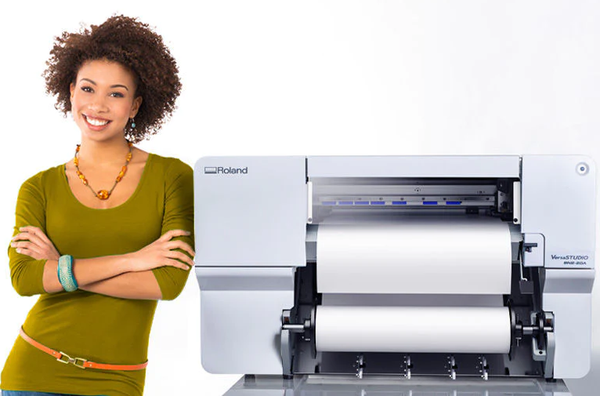DTF vs DTG: Which is the Best Alternative for Personalized Garments?
The pandemic has reshaped the landscape of small studios engaged in print-on-demand production. With it, two printing methods, DTG (Direct-to-Garment) and DTF (Direct-to-Film), have gained prominence, piquing the interest of manufacturers eager to delve into the world of personalized garments. For a long time, DTG has reigned supreme as the primary method for T-shirt printing and small-scale productions. However, in recent months, DTF has emerged as a compelling alternative, steadily amassing a dedicated following. To navigate this paradigm shift effectively, it's essential to understand the key differences between these two methods.
The Basics of DTG Printing
DTG (Direct-to-Garment) printing is a well-established technique known for its versatility and high-quality output. This method involves using specialized inkjet printers to directly apply water-based ink onto the fabric's surface. Here are some critical aspects of DTG printing:
1. Precision and Detail
DTG printing excels at capturing intricate details and producing vibrant, full-color designs. The printer's fine nozzles can render even the most complex artwork with precision.
2. Soft Feel
One of DTG's strengths is its ability to create prints that feel soft to the touch. The ink is absorbed into the fabric's fibers, resulting in a comfortable and breathable garment.
3. Ideal for Small Runs
DTG is the go-to choice for small print runs or one-off customizations. It allows for quick setup and doesn't require the creation of screens or plates.
The Advantages of DTF Printing

DTF (Direct-to-Film) printing, on the other hand, is a relatively newer entrant but has gained traction rapidly. This method involves printing designs onto a special film and then transferring them to the garment. Here's what sets DTF printing apart:
1. Vibrant Colors on Dark Fabrics
One of the standout features of DTF is its ability to produce vivid, eye-catching colors on dark fabrics. This is often challenging for DTG printers.
2. Faster Production
DTF can be quicker for larger print runs due to its streamlined film printing process. It's especially advantageous when dealing with multiple garments of the same design.
3. Durability
DTF prints tend to be more durable, especially when subjected to repeated washing and wear. The film protects the design, ensuring it retains its quality over time.
Choosing Between DTG and DTF

Both DTG and DTF have their merits, but the choice ultimately depends on your specific needs and preferences. Here are some factors to consider when deciding which method suits your business best:
1. Design Complexity
If you require intricate and colorful designs, DTG is the way to go. Its ability to reproduce fine details and gradients is unparalleled.
2. Fabric Type
Consider the type of fabric you'll be printing on. For dark-colored fabrics, DTF might be the better choice due to its color vibrancy.
3. Production Volume
For small batches or one-offs, DTG is efficient and cost-effective. However, if you're dealing with larger quantities, DTF can offer faster production times.
4. Longevity
If durability is a priority, DTF printing is known for maintaining the quality of prints even after extensive use and washing.
5. Budget
Finally, your budget plays a crucial role. DTG printers are often more affordable upfront, while DTF printing may require a higher initial investment.
In conclusion, the choice between DTG and DTF printing comes down to your specific requirements. Both methods have their strengths and can deliver outstanding results when used appropriately.
FAQs (Frequently Asked Questions)
1. Is DTF printing more expensive than DTG printing?
No, not necessarily. The cost difference between DTF and DTG printing depends on various factors, including the volume of production and the complexity of the designs. It's essential to analyze your specific needs to determine which method is more cost-effective for your business.
2. Can DTF printing be used on all types of fabrics?
DTF printing is highly versatile and can be used on various fabric types, including cotton, polyester, and blends. However, it particularly shines on dark-colored fabrics where DTG printing may face limitations.
3. Do I need specialized equipment for DTF printing?
Yes, DTF printing requires specific equipment, including a DTF printer and heat press. These machines are designed to handle the unique film transfer process, ensuring optimal results.
4. Which method is better for small-scale businesses?
For small-scale businesses and one-off customizations, DTG printing is often the preferred choice due to its flexibility, ease of setup, and cost-effectiveness.
5. How can I decide between DTG and DTF printing for my business?
To make an informed decision, assess your specific needs, budget, and the types of garments you'll be working with. Consider factors like design complexity, fabric type, and production volume to determine which method aligns best with your goals.
In conclusion, both DTG and DTF printing have their unique advantages, making them suitable for different scenarios. It's essential to evaluate your requirements carefully and weigh the pros and cons of each method to make an informed choice for your personalized garment printing business.


































![Absolute Toner $95/month 50" [FREE BONUS] AUTOMOTIVE PPF EDITION JAGUAR V-LX GCC J5-101LX-SE TINT PROTECTION FILM & TINT Cutter Window Tinting Plotter Vinyl Cutters](http://www.absolutetoner.com/cdn/shop/files/Photoroom-20250201_185430.png?v=1738485107)














